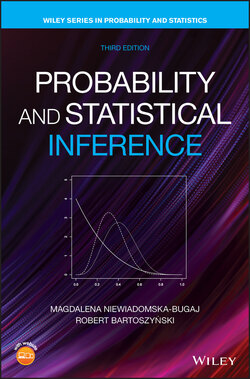Читать книгу Probability and Statistical Inference - Robert Bartoszynski - Страница 78
Problems
Оглавление1 3.2.1 A certain set contains distinct elements. Find if the number of: (i) All possible permutations of length 2 equals 90. (ii) Permutations of length 3 is 10 times larger than the number of permutations of length 2.
2 3.2.2 A skyscraper is 40 stories tall. Five people enter the elevator on the first floor. Assuming each person is equally likely to get off at any of the 39 floors what is the probability that all people will get off at different floors? Find the exact value, and then derive and compute the approximations analogous to (3.6) and (3.7).
3 3.2.3 A two letter code is to be formed by selecting (without replacement) the letters from a given word. Find the number of possible codes if the word is: (i) CHART. (ii) ALOHA. (iii) STREET.
4 3.2.4 Determine the number of 0s at the end of 16! and 27!.
5 3.2.5 Seated at random in a row of seats are people, among them John and Mary. Find the probability that: (i) John sits next to Mary. (ii) John sits next to Mary on her right. (iii) John sits somewhere to the right of Mary. (iv) John and Mary sit exactly two seats apart.
6 3.2.6 Seated at random at a round table with seats are people, among them John and Mary. (i) Answer questions (i)–(iv) of Problem 3.2.5. Anything peculiar about the answer to (iii)? (ii) Assume that Find the probability that John and Mary sit facing each other (e.g., numbers 1 and 7 on the clock). (iii) Assume that . Find the probability that good friends, Nico, Noah, and Helen, are not separated by other guests.
7 3.2.7 Five men and five women are to be seated in a row of 10 chairs. Find the number of possible arrangements if: (i) Men are required to sit in alternating seats. (ii) No two men are to be seated next to each other.
8 3.2.8 A total of 12 girls and 17 boys go to a dance. (i) How many possible dancing pairs (boy–girl) may be formed? (ii) The dance floor can accommodate at most 11 pairs at a time. If each dance lasts 10 minutes and is followed by a 2‐minute break, how much time, at least, will elapse before each boy will have danced with each girl at least once? (iii) Answer the same question as in (ii) if the dance floor can accommodate 15 pairs at a time.
9 3.2.9 Susan has five dresses, three skirts, four blouses, three pairs of shoes, and two hats. She always wears shoes and either a dress or a blouse and a skirt. She may or may not wear a hat. (i) How many different combinations can she wear? (ii) Suppose Susan can afford buying either a dress or a hat (but not both). What should she buy to maximize the number of different combinations that she can wear? (iii) Suppose that Susan's brown shoes do not match her pink or blue dress and that the blue hat does not match her yellow blouse. How many matching combinations can she wear?
10 3.2.10 A restaurant menu has 5 appetizers, 3 soups, 15 entrees, and 3 desserts. (i) Assuming you are going to order one item from each group, how many possible dinners can you order? (ii) Assume you are at the restaurant with a friend. How many different orders for two full dinners can you place if your friend's choice of every item is not necessarily the same as yours? (iii) Answer the question in part (ii) under the constraint that you do not order the same entree and the same dessert as your friend (but the soup and/or appetizer may be the same).
11 3.2.11 Find the percentage of six‐digit numbers that have all digits distinct.
12 3.2.12 A regular die is tossed times. Find the probability that: (i) Each side turns up exactly once if . (ii) Each side turns up at least once if .
13 3.2.13 Find the number of three‐digit integers (i.e., integers between 100 and 999) that have all digits distinct. How many of them are odd?
14 3.2.14 Let be the probability that exactly two people in a group of have the same birthday, and let be the probability that everybody in the group has a different birthday. Show that
